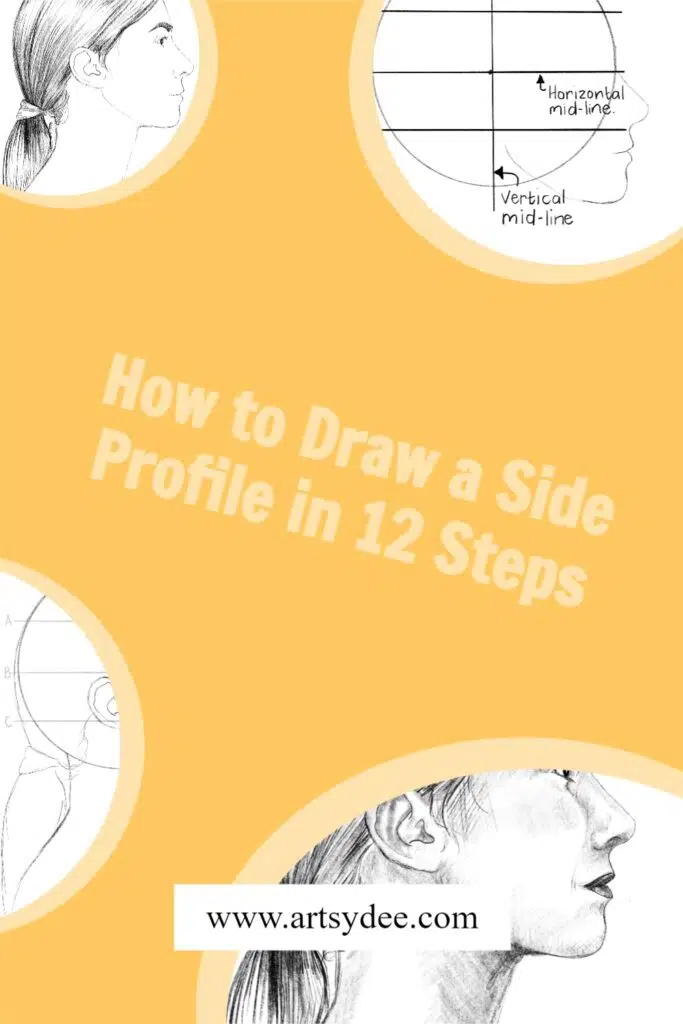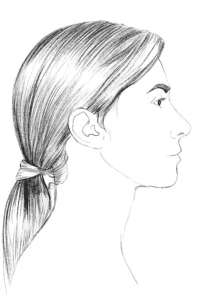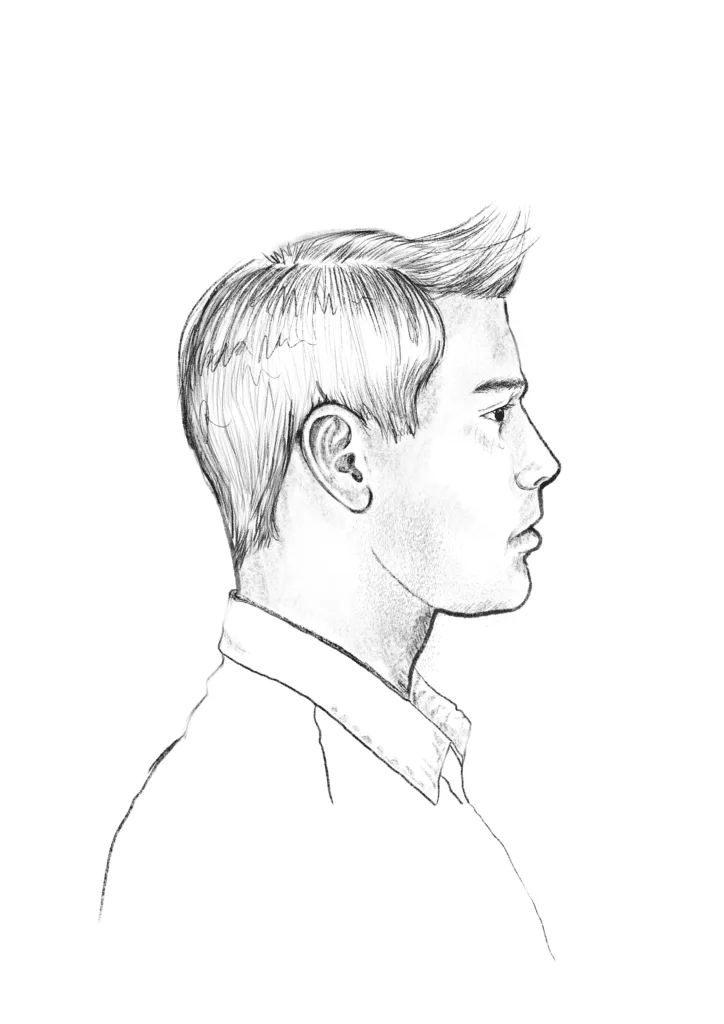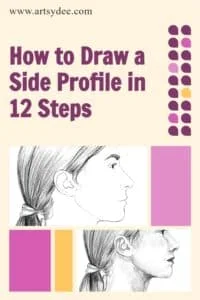Side Head Profile Clip Art Easy to Draw
I'm going to show you how to do a side profile drawing in just 12 steps. If you're an artist, art student, or just someone who is exploring how to draw, this post should be really helpful!

Drawing a side profile can seem really daunting at first glance because there are so many complex features to draw – but don't worry!
I'll walk you through it step by step and soon enough you'll have your own accurate side profile drawing. Let's get started…
Let's Draw a Female's Side Profile.

It is important to note that a female's facial features and head structure differ slightly from a male's.
For starters, a woman has a softer jawline and a rounder, more petite nose. This side profile drawing will look more like an "S" shape than the male side profile that I will draw afterward.
When you start out on your side profile drawing, it is important to remember, that just like there is a myriad of variations in facial features – no two side profiles are the same!
In other words, if your side profile drawing does not look exactly like my side profile drawing that's absolutely ok!
Keep in mind, it may be helpful for you to lightly sketch the guidelines on your drawing paper before you begin.
After all of your side profile drawing guidelines are drawn, it's time to begin!
As I said before, side profiles can seem really complicated – but don't worry …follow these steps and you will be well on your way.
Woman Side Profile Drawing Step-by-Step.
Step 1. Draw a Simple Circle

In order to do a side profile drawing accurately, you need to understand what the main structure beneath the face is.
The human skull is comprised of different shapes that make up its complete form. Start off by drawing a simple circle which will be the guideline you use to fill in the jaw, ears, eyebrows, and other facial elements.
Step 2. Add Rulers to the Circle

Draw a vertical line and a horizontal line directly down and across the middle of the circle. They will intersect at the exact midpoint.
Divide the top half of the circle and the bottom half of the circle in half and draw two more horizontal lines that run parallel to the mid-line.
These lines give you good reference points for when you start filling in your facial features and shapes.
Step 3. Outline Shape of Nose and Lips

You can now draw a light outline of the nose and the lips. The nose begins at line B (the mid-line) and comes in again at line C.
The top lip begins from line C continuing naturally into the mouth, where the bottom lip begins and continues to form the shape of the chin.
Step 4: Outline of the Chin and Jaw

The chin juts out from the base of the bottom lip and then curves inwards creating a gentle arch toward the intersection of the vertical mid-line and line C.
Remember to keep your mark-making light with not too much pressure on the pencil. This is important because you want to be able to easily erase lines, or soften lines are your drawing develops.
When you draw someone's jawline (particularly when you doing a side profile drawing of a woman), often it isn't a strong definite line that defines it, but rather a gentle gradient of shading. As a result, you don't need a strong, hard pencil line.
Remember to stand back from your drawing often! If the chin, lips, or nose do not look right, then make small adjustments and review them.
PRO TIP: Monitor the progress of your drawing by looking at it in a mirror, or through the camera on your mobile phone. This really helps your brain to see anything that looks 'wrong' or isn't working!
Step 5: Draw the Outline of the Neck

Lightly draw the outline of the back of the neck. This line gently curves outward and mirrors the line of the person's spine.
The front of the neck begins at the base of the chin, moves inward towards to body, and then starts to move outward from the collar bone at the start of the chest cavity.
Step 6: Draw the Ear

The ear is formed by drawing a tilted "C" shape. You can see the ear is slightly off-center and falls to the left of the vertical mid-line.
When a beginner first starts drawing the ear, they often spend a lot of time trying to draw all the lines and shapes within the ear – often using the same mark-making pressure throughout.
This is not the best way to go about drawing the ear because it can end up looking like it has been "stuck on" the side of the head!
It's best to define the outer shapes of the ear and then very lightly add shading to the inner shapes. If you soften the shapes within the ear, the ear appears to fit more naturally on the profile.
Step 7: Draw the Eye

The middle of the eye (and where the corner of the eye comes together) falls on the horizontal mid-line (Line B).
The eye shape is a basic 'V' shape turned on its side, with an ellipse for the iris.
The top of the eyelid is defined with a single line.
I have also added eyelashes to the top eyelid.
Step 8: Define the Nose and Nostril

Create a sense of the nostril by drawing a tilted 'C' shape, and adding the nostril itself. The 'C' shape of the nostril will sit on line C.
Step 9: Draw the Eyebrow
Draw the shape of the eyebrow, beginning at the edge of the forehead and ending just beyond the edge of the eye.
The eyebrow starts off thicker and curves towards a tapered end.
Make sure to draw this shape very lightly, because you will erase it as you start the actual shading of the side profile drawing.
PRO TIP: To shade eyebrows you should follow the direction of the eyebrow hairs. Start with your pencil tip at the base of the hair and flick your pencil in the direction of the eyebrow hair. In this case, it would be up and the left. Repeat this exercise until your eyebrow is fully shaded.
Step 10: Draw the Outline of the Hair

I have chosen to draw this woman with straight, long hair, tied in a ponytail at the base of her neck.
Make sure to follow the base circle of the skull to get the shape of the hairline accurately rendered.
The hairline will cut across the side profile and tuck in behind the ear, ending almost on the same horizontal line as the jawline.
Step 11: Shade the Hair

Following the same principle as eyebrow shading, try to follow the direction of the woman's natural hair with your shading.
I worked into the hair with repeated lines that I made darker and closer together in the shaded areas, and lighter and further apart in the highlights.
Step 12: Final Shading of the Face

Using soft tonal gradation and blending gently build up the shadow areas on the side profile.
Take note of the shadows under the chin and down the neck, under the lips, under the nose, and beside the eye on the nose.
The side profile will also have a natural shadow where the hair meets the skin.
PRO TIP: To create tonal gradation and blending hold your pencil almost parallel to the surface of the paper so that the lead is on its side. Using broad strokes gently build up the surface of the side profile. Use a kneadable eraser to "dab" off areas of pencil and highlights.
Let's Draw a Male's Side Profile

Male Side Profile Drawing
Drawing a male's side profile differs from drawing a female's side profile.
For starters, the side profile is more angular than a female side profile.
A male side profile also tends to have an unevenness around the hairline, with sharp corners where the side of the head meets the hair.
A male will also often have sideburns and stubble.
A male side profile is often more defined and angular than that of a female side profile.
Step 1. Draw a Simple Circle

Start off by drawing a simple circle which will be the guideline you use to fill in the jaw, ears, eyebrows, and other facial elements.
Step 2. Add Rulers to the Circle

Draw a vertical line and a horizontal line directly down and across the middle of the circle. They will intersect at the exact midpoint.
Divide the top half of the circle and the bottom half of the circle in half and draw two more horizontal lines that run parallel to the mid-line.
These lines give you good reference points for when you start filling in your facial features and shapes.
Step 3. Outline Shape of the Nose

You can now draw a light outline of the nose. The nose begins at line B (the mid-line) and comes in again at line C.
Step 4. Draw the Outline of the Top Lip

The top lip begins from line C continuing naturally into the mouth.
PRO TIP: Monitor the progress of your drawing by looking at it in a mirror, or through the camera on your mobile phone. This really helps your brain to see anything that looks 'wrong' or isn't working!
Step 5. Draw the Outline of the Bottom Lip

The bottom lip begins and continues to form the shape of the chin.
The chin juts out from the base of the bottom lip and then curves inwards creating a gentle arch toward the intersection of the vertical mid-line and line C.
Remember to keep your mark-making light with not too much pressure on the pencil. This is important because you want to be able to easily erase lines, or soften lines are your drawing develops.
When you draw someone's jawline (particularly when you do a side profile drawing of a woman), often it isn't a strong definite line that defines it, but rather a gentle gradient of shading. As a result, you don't need a strong, hard pencil line.
Remember to stand back from your drawing often! If the chin, lips, or nose do not look right, then make small adjustments and review them.
Step 6: Draw the Jaw Line

This male's jawline has a curve to it and begins at the base of the ear, curves around towards the chin, and then meets the bottom lip.
Remember that a male's jawline is far more angular than a female's jawline!
Step 7: Draw the Neckline

Lightly draw the outline of the back of the neck. This line gently curves outward and mirrors the line of the person's spine.
The front of the neck begins at the base of the chin, moves inward towards to body, and then starts to move outward from the collar bone at the start of the chest cavity.
In this sketch, I have added a collared shirt to help define the line of the neck.
Step 8: Draw the Ear

The ear is formed by drawing a tilted "C" shape. You can see the ear is slightly off-center and falls to the left of the vertical mid-line.
When a beginner first starts drawing the ear, they often spend a lot of time trying to draw all the lines and shapes within the ear – often using the same mark-making pressure throughout.
This is not the best way to go about drawing the ear because it can end up looking like it has been "stuck on" the side of the head!
It's best to define the outer shapes of the ear and then very lightly add shading to the inner shapes. If you soften the shapes within the ear, the ear appears to fit more naturally on the profile.
Step 9: Draw the Eye and Define the Nose and Lips

The middle of the eye (and where the corner of the eye comes together) falls on the horizontal mid-line (Line B).
The eye shape is a basic 'V' shape turned on its side, with an ellipse for the iris.
The top of the eyelid is defined with a single line.
I have also added eyelashes to the top eyelid.
Create a sense of the nostril by drawing a tilted 'C' shape, and adding the nostril itself. The 'C' shape of the nostril will sit on line C.
Step 10: Draw the Eyebrow

Draw the shape of the eyebrow, beginning at the edge of the forehead and ending just before the edge of the eye.
PRO TIP: To shade eyebrows you should follow the direction of the eyebrow hairs. Start with your pencil tip at the base of the hair and flick your pencil in the direction of the eyebrow hair. In this case, it would be up and the left. Repeat this exercise until your eyebrow is fully shaded.
Step 11: Draw and Shade the Hair

Following the same principle as eyebrow shading, try to follow the direction of the man's natural hair with your shading.
I worked into the hair with repeated lines that I made darker and closer together in the shaded areas, and lighter and further apart in the highlights.
Step 12: Final Shading of the Face

Using soft tonal gradation and blending gently build up the shadow areas on the side profile.
Take note of the shadows under the chin and down the neck, under the lips, under the nose, and beside the eye on the nose.
The side profile will also have a natural shadow where the hair meets the skin.
PRO TIP: To create tonal gradation and blending hold your pencil almost parallel to the surface of the paper so that the lead is on its side. Using broad strokes gently build up the surface of the side profile. Use a kneadable eraser to "dab" off areas of pencil and highlights.
Tools and Materials Needed:
Graphite or Lead Pencils (2B, 4B, 6B, 8B)
Sharpener
Kneadable Eraser
Ruler
Paper or Sketchbook (The paper must be strong enough to withstand firm erasing of lines)

Frequently Asked Questions about Side Profile Drawing
What is a profile portrait?
A side profile portrait is a drawing of the side view of the head and face.
Here is a great video on how to draw a Manga Side Portrait!
Why is drawing faces so hard?
It is only hard to get started. Once you have mastered the side profile portrait, it will be much easier to draw faces from other angles.
How do you fix drawing mistakes?
There are several ways to fix drawing mistakes. First, make sure you always start drawing with a soft touch. Use soft, light lines to sketch out your artwork.
Second, use a kneadable eraser to lift graphite without damaging the paper.
Finally, you can always draw on top of your mistake with a darker tone to cover up the mistake if needed.
How do you identify drawing mistakes?
Everyone makes mistakes in their drawing. The best way to identify these errors is by regularly standing back and looking at your work from a wider angle.
You can also hold up your drawing in front of a mirror, or look at the artwork through your mobile's camera! This is a great way to help your brain spot inaccuracies and problem areas in your drawing.
What are common mistakes people make when drawing human faces?
The most common mistakes people make when drawing human faces include making the person's eyes too big, and the nose too small.
People struggle with getting the facial features in proportion. This is why it's good to use a tool or step-by-step methodology like the one I have created above, to get more accurate results.
You can also read my article on How to Improve Your Drawing.
Other Drawing Articles that you might enjoy
How to Start Drawing
How to Improve Your Drawing
How to Start a Daily Sketchbook
Common Drawing Mistakes

Conclusion
Creating your own side profile drawing can be a fun and easy way to practice drawing. You'll also gain insight into the differences between male and female features.
I hope this article has helped you confidently create your own beautiful portraits! If you enjoyed it, please share with friends on social media or in person.
Remember that everyone is unique so don't compare yourself too closely against what's seen here; just use these examples as general guidelines for how different people might draw their profiles differently from one another.
Happy sketching!
Side Head Profile Clip Art Easy to Draw
Source: https://artsydee.com/side-profile-drawing/
0 Response to "Side Head Profile Clip Art Easy to Draw"
Post a Comment